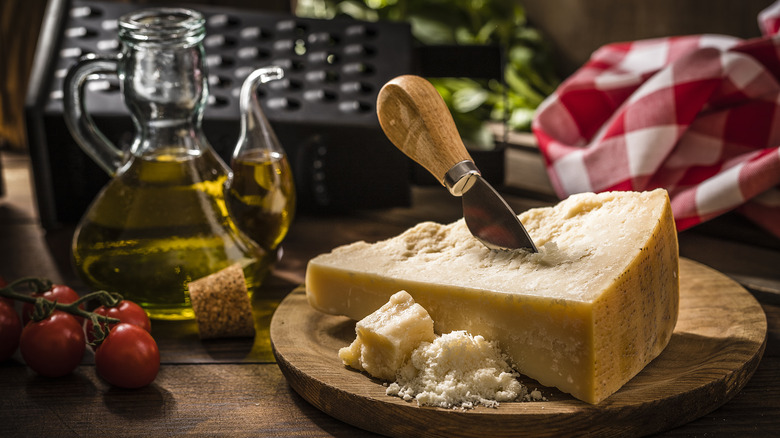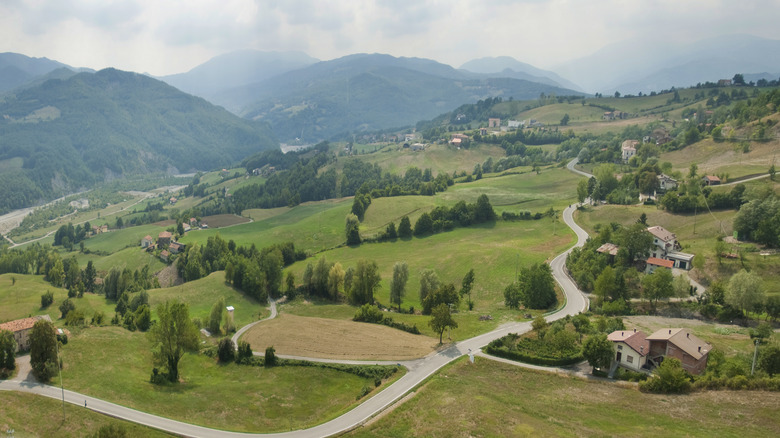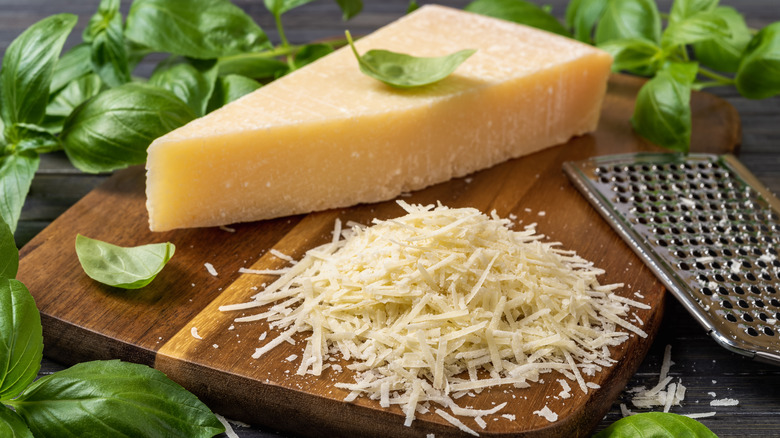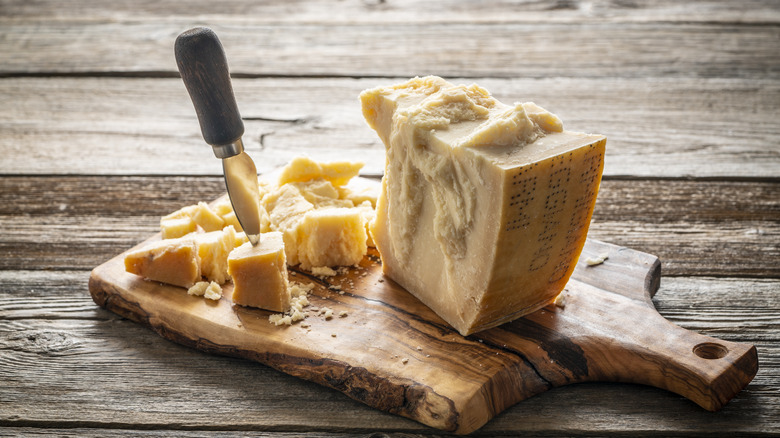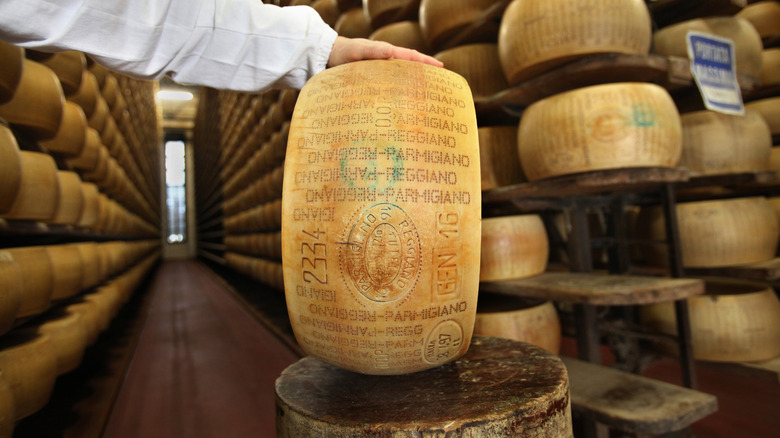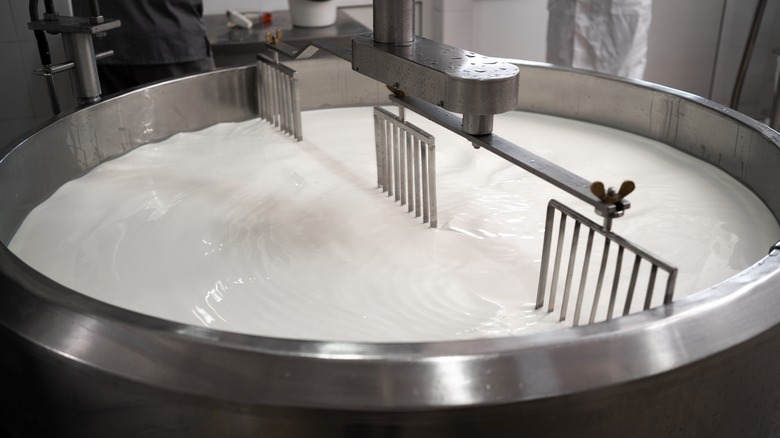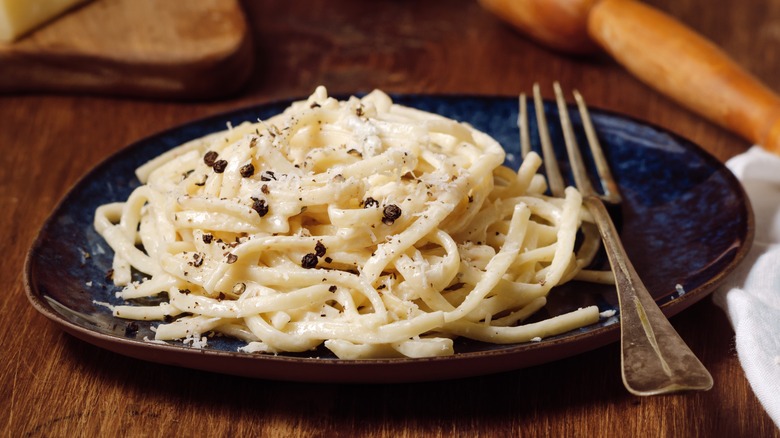What's The Difference Between American And Italian Parmesan?
Parmesan cheese is one of the most delicious and versatile ingredients in a cooking arsenal, which makes all of the labeling conventions around cheese that much more frustrating. Parmesan isn't just for pasta or adding a cheesy taste, it's a multi-purpose source of salt and umami flavors that can elevate anything from sauces and soups to roasted vegetables. But, in order to use it well, you have to know what kinds of flavors and textures you're getting when you buy it. Unfortunately, in the U.S., the quality of parmesan can vary wildly from one brand to another, and a lot depends on where it's produced.
It's not that Italian parmesan is inherently better than parmesan produced in the United States, but the two vary enough in their characteristics that you should really understand the difference. They fill the same general roles in cooking and they can definitely be subbed for each other most of the time, but everything from the price to the tasting notes to the texture can be quite different if the parmesan you buy is from Italy.
The original form of the cheese that American parmesan is based on is usually more complex, sharp, and gritty in texture. Most of those differences stem from the history and traditions of the cheese in Italy along with the environment it comes from and the regulatory environments in both countries, which heavily influence how parmesan is produced.
What is Italian parmesan?
The Italian version of parmesan won't be labeled as such; it will be called Parmigiano-Reggiano. The name comes from Parma, a city in the Northern Italian region of Emilia-Romagna. The history of cheesemaking in Parma dates back to the Roman Empire, with evidence of its modern form going all the way back to written records from 1200, according to the Parmigiano-Reggiano Consortium. It was produced by monks using salt from the local mines, and the large, dry wheels of cheese were made to be preserved for a long time. Records even indicate that it was being used to flavor pasta like gnocchi and ravioli back then, much like today.
Parmigiano-Reggiano is a DOP food — the Italian label for "Protected Designation of Origin," which means that the way it's produced is strictly regulated to protect its heritage, and cheese not produced according to code cannot legally use the name. It can only be made in the Italian regions of Parma, Reggio Emilia, Modena, Mantua, or Bologna and can only use three ingredients: rennet, salt, and raw milk. The milk used in Parmigiano-Reggiano must be from local cows that are fed on local forage, and it's the unique microbiology of the native plants that the cows eat that is supposed to give the cheese its distinctly complex flavor. Italian parmesan cannot contain any preservatives or artificial ingredients and must be aged for a minimum of 12 months before it's sold, with some versions aged 40 months or more.
What is American parmesan?
The American version of parmesan is far less regulated than the cheeses from Italy, but you still can't just call anything parmesan. U.S. regulations say that anything called parmesan must be made from cow's milk, have a hard, brittle texture, and be aged for at least 10 months. American parmesan is one of the only cheeses outside of Italy that uses the name. European courts ruled that the name "parmesan," was legally covered by the protections for Parmigiano-Reggiano, while American courts have ruled that only the original Italian name was legally protected. This has led to a lot of confusion between the two labels for U.S. consumers.
Because of the less strict regulations, American parmesan varies a lot more. Some brands that were started by Italian immigrants, like Grande, go above and beyond to copy the Italian style, while others are much looser with the quality of ingredients or are more experimental with flavors. The milk and cows can come from anywhere, and American producers are free to bleach their milk or use additives like calcium chloride and artificial coloring. And, pre-grated parmesan will have plant cellulose added to prevent clumping, which can sometimes comprise up to 20% of the bottle. None of this means that American parmesan is "fake" cheese, as many domestic versions are quite good, but it makes it harder to determine the quality and characteristics of what you are getting.
Both American and Italian parmesan are hard, crumbly cheeses
The one area where there is the most overlap between American and Italian parmesan is in the texture. More than anything, the hard, grateable nature of Parmigiano-Reggiano is what American regulations require and what many manufacturers are trying to replicate. The U.S. Food and Drug Administration defines parmesan as: "Characterized by a granular texture and a hard and brittle rind." Grated over a plate of pasta, you won't notice much difference in the two versions with it comes to texture.
However, there is one area where they differ in texture, which is especially apparent when the cheese is eaten by itself. Parmigiano-Reggiano usually has more distinct crystal structures in it, which adds a pleasingly crunchy bite that many American versions lack. Those crunchy pieces are sometimes mistaken for salt crystals but are actually a result of the longer aging process of the Italian-made cheese. The longer cheese sits, the more the bonds that hold certain amino acids in place (in this case tyrosine) break down. These loose bits then combine and restructure into the crystals studded throughout Parmigiano-Reggiano. That's just one of the advantages of a cheese that can be aged for years.
Italian parmesan has a complex, aged taste
The unique local production of Italian Parmigiano-Reggiano, along with the longer aging process, produces a much stronger taste with a lot of different flavor notes compared to the American-made styles. As cheeses age, they lose moisture, which concentrates flavor. The breakdown of lactose creates new acids with new tastes. The defining flavor of Parmigiano-Reggiano is its mix of fruity and nutty notes with a strong, savory umami sensation.
But, Parmigiano-Reggiano can develop even more flavors depending on its age category. It is classified into four groups: 12-18 months, 22-24 months, 30-36 months, and 40-plus months. The 24-month range is the most common and recognizable; beyond that, Parmigiano-Reggiano will start to develop hints of spices and even meaty, beefy undertones.
American parmesan normally has more of a straightforward salty cheese flavor that's closer to the least-aged 12 to 18-month varieties. That doesn't mean you can't prefer the flavor of younger parmesan, especially if you like a more milky, dairy-flavored cheese. There are also American versions that get closer to the Italian styles with a longer aging process. American parmesan's more one-note salty taste does make it less distinct, however, and its flavor is sometimes hard to distinguish from other aged cheeses like cheddar.
American parmesan is made with pasteurized milk
While the differences in taste and texture between American and Italian parmesan come from a variety of factors, one of the biggest is how the primary ingredient, milk, is handled. Parmigiano-Reggiano must be made with raw milk, while U.S. parmesan is made with pasteurized milk. Rules about consuming raw milk are much stricter in the U.S. because the FDA considers the bacteria in unpasteurized milk unsafe.
In fact, it's illegal to sell many raw milk cheeses in the U.S., even if it's produced in countries where it's legal to make. The only raw milk cheeses that can be sold in America are ones that have been aged for 60 days or more before being sold. This excludes many traditional soft cheeses from Europe but thankfully does allow the import of Parmigiano-Reggiano and other hard cheeses, like Gruyère, where long aging is standard anyway.
Why does this matter for American parmesan? Well, pasteurization involves heating milk to 145 degrees Fahrenheit or higher to kill pathogens like listeria. However, this also kills lots of "good" bacteria that bring both flavor and potential health benefits. Raw milk is noticeably more flavorful than pasteurized milk, and this is multiplied in the concentrated form of cheese. Killing bacteria means pasteurized milk can lose that sense of place that you get from local ingredients, which is so valued by artisan cheesemakers and is what makes Parmigiano-Reggiano such a beloved product.
Italian parmesan is good for dishes where cheese is the star
While cheese lovers may prefer the deeper taste of aged Italian Parmigiano-Reggiano, the reality is that both styles have their uses. The subtle, complex notes of the Italian cheese are delicious, but they may get lost if you are using it in dishes where it's just in a supporting role. Parmigiano-Reggiano is a great cheese for snacking and eating straight, like on a charcuterie board, where its powerful flavor will delight your taste buds, and its umami and nutty notes will pair well with the meats. It's also essential to making a great cacio e pepe, where grated parmesan is the main flavor, and inferior versions will produce something far less magical. The same thing goes for a classic risotto, where the depth of Parmigiano-Reggiano is the key to an intensely flavorful final product.
American parmesan is good for places where you just need to add some salty, rich notes. If you want to sprinkle some grated parmesan over a tomato-sauce pasta dish, American versions work well, whereas the flavors of Parmigiano-Reggiano can be lost to the acidic sauce. If you are making a soup and want to add a little something extra at the end, or if your salad dressing needs a savory punch-up, American parmesan is a good option there too. Like any food, it will come down to personal preference. Wherever American parm works for you is a great spot to use it.
